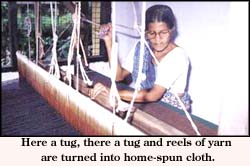
5th December 1999
News/Comment|
Editorial/Opinion| Business| Sports|
Sports Plus| Mirror Magazine

Dying weave
women are saying 'no' to looms and 'yes'
to garment factories
By Laila Nasry
 A
forty-year-old woman sits at a loom. Her nimble fingers thread the yarn,
tighten the weft and send the shuttle racing across the warp. She tugs
here and she tugs there, her hands and feet working in synchronised movements.
The loom clatters and jerks and starts to life as the workshop echoes with
its stacatto rhythm. The rest is magic, as she converts reels of yarn into
beautiful home-spun cloth.
A
forty-year-old woman sits at a loom. Her nimble fingers thread the yarn,
tighten the weft and send the shuttle racing across the warp. She tugs
here and she tugs there, her hands and feet working in synchronised movements.
The loom clatters and jerks and starts to life as the workshop echoes with
its stacatto rhythm. The rest is magic, as she converts reels of yarn into
beautiful home-spun cloth.
The handloom industry is as old as Sri Lanka's recorded history, dating back to the time when Vijaya landed in the then Thambapanni to find Kuveni spinning yarn. Since then handlooms have come a long away. "The best days were during my daddy's time, in the 60s and early 70s," recounts Padmini Senanayake, proprietor of Polgolla Handlooms, a firm started by her father. "Then, handlooms were catering to the basic clothing needs of the time. But the open economic policies introduced during 1977 changed the industry completely."
All at once the market was flooded with imported textiles and clothing.
Overnight nearly 40,000 weavers lost their jobs and the existence of the
handloom sector was threatened.
Twenty-two years later, though handlooms have survived, the sector
has not quite recovered. The main problem today is the reluctance of young
people to enter the industry, because of its low income levels. "The young
women of today also find the work too strenuous for their liking," says
Sandra Wanduragala of Selyn Exports, as the few young women who work in
the yarn section of her workshop nod in agreement.
In the past, the handloom sector was dominated by women. "But they see no future in this sector. Weave and then what?" Mrs. Wanduragala asks. "The stigma attached to weaving discourages many young women; they prefer jobs in garment factories," Mrs. Senanayake adds. The fact that many in her workforce are over 40 is proof of this. "The possibility that the sector will die with the present generation is quite likely," she added.
The handloom market is an exclusive one. Be it handloom materials or the finished products, they have to be tasteful. "This is where the well-established firms like Barefoot and Selyn Exports have an edge over others, for they are better versed in consumer wants, and know how to cater to them," D.P. Gunewardene, a consultant to the handloom sector explained. "No longer are handlooms the bread and butter of the rural folk who are loomholders through generations. They are not used to the tastes of this exclusive market." The colour schemes and designs play an important role and it is here that the small loomholders fail to create a ripple. Thus more and more smallholders are left on the sidelines unable to compete with the big players.
State policies too have had a detrimental effect on the industry. The government acts as an advisory body and it is the provincial councils that carry out the functions. Like in many other sectors this two-pronged management does not bring the desired results. The money invested in the sector is handled by the provincial councils which cater to the middle market.
"The private sector gets no assistance, even though we supply the niche market (upmarket) in which there are returns," Mrs. Wanduragala said. "The government feels it is a loss to invest more money because there are no returns. But, they are investing it on the wrong people. All assistance in relation to market research and training of weavers goes to provincial councils. The same people are trained over and over again and obviously there is no advancement in the industry."
Shortsighted policies have also resulted in the private sector losing their niche market. Mrs. Wanduragala was vehement: "There are no restrictions on imports. As a result the market is flooded with handloom sarongs and other items which are sold at a much lower price on the pavement. How can we compete?" As a result the exclusivity of the product is lost.
However they were all praise for the work done by the Vocational Training for Women (VTW) and the GTZ in this sector. The Handloomers' Collective formed through their initiative has helped to a great extent, for we share ideas and information which is useful, said Mrs. Wanduragala and Mrs. Senanayake.
The handloom industry's greatest strength is that there is a demand for natural products worldwide. Further the industry has the potential to be developed in the rural areas where basic infrastructure facilities for other industries are not available. "The government is paying Samurdhi for nothing. If it could pay Samurdhi on the basis that the receivers work in a handloom mill, it would not only revitalise the industry but also provide solutions to the unemployment problem," Mrs. Wanduragala said . "The current popularity of handloom fabrics should be nurtured for in it lies a goldmine."
"Clear policies need to be drafted to salvage this sector. A national policy with regard to handlooms has to be clearly established. A well defined set of incentives for both the corporate and private sector have to be set, for at least a period of five years, " was Mr. Gunewardene's hope for the sector.








![]()
Front Page| News/Comment| Editorial/Opinion| Plus| Business| Sports| Sports Plus| Mirror Magazine
Please send your comments and suggestions on this web site to

